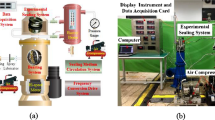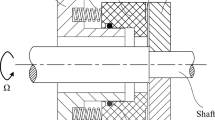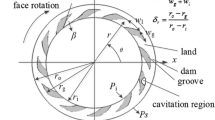Abstract
A thermo-hydrodynamic model was introduced by considering fluid film phase change to analyze the stability of a spiral groove mechanical seal under high speeds. The Reynolds equation, energy equation and heat conduction equation were solved using the finite difference method. Two kinds of phase state stability criteria and fluid film temperature or pressure distributions in each phase state were studied. Different phase states of fluid film and phase state stability of such a spiral groove mechanical seal under variable operating and geometry conditions were analyzed. The results show that vapor mass fraction volume ratio vs sealed fluid temperature (κ-Tf) curve and film pressure coefficient versus sealed fluid temperature (Km-Tf) curve can be used as phase state stability criteria which can predict the range of instability, stability and quasi-stability of a spiral groove mechanical seal. But the Km-Tf curve is more suitable for practical engineering applications. It is found that a significant change in pressure distribution will bring about instability of a spiral groove mechanical seal. The sudden change of film pressure distribution usually occurs when the leakage flow medium in the interface is in the transition phase from quasi-liquid to quasi-vapor where κλ=0 = κ0<λ<1 and κλ=1 = 0. Optimized design of a spiral groove mechanical seal will improve its stability during the phase change from liquid phase state to vapor phase state.





















Similar content being viewed by others
Abbreviations
- A f :
-
Sealing surface area (m2)
- c p :
-
Specific heat capacity (kJ kg−1 K−1)
- c p sv, c P sl :
-
Specific heat capacity of saturated liquid phase and saturated vapor phase, respectively (kJ kg−1 K−1)
- D :
-
Outer diameter of the seal ring (m)
- D 1, D 2, D 3 :
-
Transition point
- F open :
-
Opening force (N)
- h :
-
Film thickness (μm)
- h s, h r :
-
Height of rotational ring and stationary ring, respectively (m)
- h fr, h fs, h c :
-
Convection heat transfer coefficient (W m−2 K−1)
- h p :
-
Groove depth (μm)
- i :
-
Enthalpy (kJ kg−1)
- i s :
-
Mixture of enthalpy (kJ kg−1)
- i sv, i Sl :
-
Enthalpy of saturated liquid phase and saturated vapor phase, respectively (kJ kg−1)
- k z :
-
Film axial stiffness (N μm−1)
- k r, k s :
-
Thermal conductivity of rotational ring and stationary ring, respectively (W m−1 K−1)
- k f :
-
Thermal conductivity of the fluid (W m−1 K−1)
- k f sv, k f sl :
-
Thermal conductivity of saturated liquid phase and saturated vapor phase, respectively (W m−1 K−1)
- K m :
-
Film pressure coefficient
- n :
-
Angular velocity (r min−1)
- N :
-
Groove number
- p :
-
Pressure (MPa)
- p o :
-
Pressure at outer radius (MPa)
- p i :
-
Pressure at inner radius (MPa)
- Pr :
-
Prandtl number
- q r :
-
Heat flux between the film and rotational ring (W m−2)
- q s :
-
Heat flux between the film and stationary ring (W m−2)
- r :
-
Radius (m)
- r g :
-
End radius of the spiral groove (m)
- r o :
-
Outer radius of seal face (m)
- r i :
-
Inner radius of seal face (m)
- T :
-
Temperature (K)
- T f :
-
Sealed fluid temperature (K)
- T r :
-
Temperature of rotational ring (K)
- T s :
-
Temperature of stationary ring (K)
- μ :
-
Dynamic viscosity (Pa s)
- μ sv, μ sl :
-
Density of saturated liquid phase and saturated vapor phase, respectively (Pa s)
- ρ :
-
Density (kg·m−3)
- ρ sv, ρ sl :
-
Density of saturated liquid phase and saturated vapor phase, respectively (kg m−3)
- θ :
-
Coordinate (rad)
- α :
-
Spiral angle (deg)
- β :
-
Groove-to-land ratio
- γ :
-
Groove-to-dam ratio
- κ :
-
Vapor mass fraction volume ratio
- λ :
-
Vapor mass fraction
- ω :
-
Rotational speed (rad s−1
References
Harrison M, Watkins R (1984) Evaluation of forties mail oil line pump seals. Proceedings of the Tenth International Conference on Fluid Sealing. Innsbruck, Austria
Rhodes DB, Hill RC, Wensel RG (1987) Reactor coolant pump shaft seal stability during station blackout. United States 6461131. https://www.osti.gov/servlets/purl/6461131
Denny DF (1961) Some measurements of fluid pressures between plane parallel thrust surfaces with special reference to the balancing of radial face seals. Wear 4(1):64–83. https://doi.org/10.1016/0043-1648(61)90242-3
Lau SY, Hughes WF, Basu P et al (1990) A simplified model for two phase face seal design. Tribol Trans 33(3):315–324. https://doi.org/10.1080/10402009008981961
Yasuna JA, Hughes WF (1990) A continuous boiling model for face seals. J Tribol 112(2):266–274. https://doi.org/10.1115/1.2920252
Orcutt FK (1969) An Investigation of the operation and failure of mechanical face seals. J Lubr Tech 91(4):713–725. https://doi.org/10.1115/1.3555029
Arauz GL, San Andre L (1998) Analysis of two-phase flow in cryogenic damper seals—part II: model validation and predictions. J Tribol 120(2):228–233. https://doi.org/10.1115/1.2834414
Peng XD, Jin J, Meng XK et al (2019) Research progress on the liquid face seal of vapor-liquid two-phase flow. Tribology 39(5):643–655 ((in Chinese))
Wang T, Huang WF, Liu Y et al (2014) Experimental study of two-phase mechanical face seals with laser surface texturing. Tribol Int 72:90–97. https://doi.org/10.1016/j.triboint.2013.12.009
Wang T, Huang WF, Liu Y et al (2014) A homogeneous phase change model for two-phase mechanical seals with three-dimensional face structures. J Tribol 136(4):041708. https://doi.org/10.1115/1.4028043
Liu W, Liu Y, Wang YM et al (2011) Parametric study on a wavy-tilt-dam mechanical face seal in reactor coolant pumps. Tribol Trans 54(6):878–886. https://doi.org/10.1080/10402004.2011.611325
Becker KM (1963) Measurements of convective heat transfer from a horizontal cylinder rotating in a tank of water. Int J Heat Mass Transfer 6(12):1053–1062. https://doi.org/10.1016/0017-9310(63)90006-1
Abbas N, Nadeem S, Malik MY (2020) On extended version of Yamada-Ota and Xue models in micropolar fluid flow under the region of stagnation point. Phys A 542:123512. https://doi.org/10.1016/j.physa.2019.123512
Abbas N, Malik MY, Nadeem S (2020) Stagnation flow of hybrid nanoparticles with MHD and slip effects. Heat Transfer 49(1):180–196. https://doi.org/10.1002/htj.21605
Abbas N, Malik MY, Alqarni MS et al (2020) Study of three dimensional stagnation point flow of hybrid nanofluid over an isotropic slip surface. Phys A 554:124020. https://doi.org/10.1016/j.physa.2019.124020
Abbas N, Nadeem S, Saleem A et al (2020) Models base study of inclined MHD of hybrid nanofluid flow over nonlinear stretching cylinder. Chin J Phys 69:109–117. https://doi.org/10.1016/j.cjph.2020.11.019
Nadeem S, Abbas N (2019) Effects of MHD on modified nanofluid model with variable viscosity in a porous medium. Mohsen Sheikholeslami Kandelousi, Sadia Ameen, M. Shaheer Akhtar and Hyung-Shik Shin, IntechOpen. https://www.intechopen.com/books/nanofluid-flow-in-porous-media/effects-of-mhd-on-modified-nanofluid-model-with-variable-viscosity-in-a-porous-medium
Zhang GY, Zhao WG (2014) Design and experimental study on the controllable high-speed spiral groove face seals. Tribol Lett 53(2):497–509. https://doi.org/10.1007/s11249-013-0291-y
Ma XZ, Meng XK, Wang YM et al (2019) Suction effect of cavitation in the reverse-spiral-grooved mechanical face seals. Tribol Int 132:142–153. https://doi.org/10.1016/j.triboint.2018.12.022
Migout F, Brunetière N, Tournerie B (2015) Study of the fluid film vaporization in the interface of a mechanical face seal. Tribol Int 92:84–95. https://doi.org/10.1016/j.triboint.2015.05.029
Rouillon M (2017) Modeling and experimental characterization of hydrodynamic facial seals. Dissertation, University of Poitiers
Ma CH, Bai SX, Peng XD (2016) Thermo-hydrodynamic characteristics of spiral groove gas face seals operating at low pressure. Tribol Int 95:44–54. https://doi.org/10.1016/j.triboint.2015.11.001
San Andrés L, Kim TH (2010) Thermohydrodynamic analysis of bump type gas foil bearings: a model anchored to test data. J Eng Gas Turbines Power 132(4):042504. https://doi.org/10.1115/1.3159386
Wallis G (1969) One-dimensional two-phase flow. Mc Graw-Hill, New York
Zhang GY, Chen GZ, Zhao WG et al (2018) Optimization and test of parameters of the cryogenic hydrodynamic mechanical seal. J Aerosp Power 33(05):1093–1102 ((in Chinese))
Ruan SR, Green I (1997) A mixed lubrication model of liquid/gas mechanical face seals. Tribol Trans 40(4):647–657
Hughes WF, Winowich NS, Birchak MJ et al (1978) Phase change in liquid face seals. J Lubr Tech 100(1):74–79. https://doi.org/10.1115/1.3453117
Basu P, Hughes WF, Beeler RM (1987) Centrifugal inertia effects in two-phase face seal films. Tribol Trans 30(2):177–186. https://doi.org/10.1080/05698198708981746
Buck GS Jr (1980) A methodology for design and application of mechanical seals. Tribol Trans 23(3):244–252. https://doi.org/10.1080/05698198008982966
Peng XD, Xie YB, Gu YQ (2003) Evaluation of mechanical face seals operating with hydrocarbon mixtures. Tribol Int 36(3):199–204. https://doi.org/10.1016/S0301-679X(02)00172-X
Peng XD, Xie YB, Gu YQ (2006) Simpler method for volatile medium pump mechanical seals. Proc Inst Mech Eng Part J J Eng Tribol 220(7):643–647. https://doi.org/10.1243/13506501J03104
Blasiak S, Pawinska A (2015) Direct and inverse heat transfer in non-contacting face seals. Int J Heat Mass Transfer 90:710–718. https://doi.org/10.1016/j.ijheatmasstransfer.2015.07.004
Yang X, Peng XD, Meng XK et al (2019) Thermo-elasto-hydrodynamic analysis of triangular textured mechanical face seals. J Zhejiang Univ Sci A 20(11):864–881. https://doi.org/10.1631/jzus.A1900163
Meng XK, Zhao WJ, Shen MX et al (2018) Thermohydrodynamic analysis on herringbone-grooved mechanical face seals with a quasi-3D model. Proc Inst Mech Eng Part J J Eng Tribol 232(11):1402–1414. https://doi.org/10.1177/1350650117752952
Thomas S, Brunetiere N, Tournerie B et al (2007) Thermoelastohydrodynamic behavior of mechanical gas face seals operating at high pressure. J Tribol 129(4):841–850. https://doi.org/10.1115/1.2768086
Nau BS (1990) Research in mechanical seals. Proc Inst Mech Eng Part C J Mech Eng Sci 204(63):349–376
Dolan PJ, Harrison D, and Watkins R (1987) Mechanical seal selection and testing. Proceedings of the eleventh international conference on fluid sealing, BHRA fluid engineering, Cranfield, U.K. https://doi.org/10.1243/PIME_PROC_1990_204_117_02
Jie J, Xudong P, Jinbo J et al (2020) Frictional characteristics of impregnated graphite with different graphitization degree versus chromium stainless steel under varying PV values. Tribol Int 146:106063. https://doi.org/10.1016/j.triboint.2019.106063
Qiu Y, Khonsari MM (2012) Thermohydrodynamic analysis of spiral groove mechanical face seal for liquid applications. J Tribol 134(2):021703. https://doi.org/10.1115/1.4006063
Acknowledgements
The research work is supported by the National Natural Science Foundation of China (U1737202, 51775505, 52076195) and the National Key R&D Program of China (2018YFB2000800).
Author information
Authors and Affiliations
Contributions
JJ designed the research, processed the corresponding data and wrote the first draft of the manuscript. XDP designed the research, built the model and revised the manuscript. XKM helped to organize the manuscript. WJZ and JBJ revised and edited the final version.
Corresponding author
Ethics declarations
Conflict of interest
Jie Jin, Xu-dong Peng, Xiang-Kai Meng, Wen-Jing Zhao and Jinbo Jiang declare that they have no conflict of interest.
Additional information
Technical Editor: Erick Franklin.
Publisher's Note
Springer Nature remains neutral with regard to jurisdictional claims in published maps and institutional affiliations.
Rights and permissions
About this article
Cite this article
Jin, J., Peng, XD., Meng, XK. et al. Analysis of stability of two-phase flow mechanical seal with spiral groove under high speeds. J Braz. Soc. Mech. Sci. Eng. 43, 260 (2021). https://doi.org/10.1007/s40430-021-02985-8
Received:
Accepted:
Published:
DOI: https://doi.org/10.1007/s40430-021-02985-8




